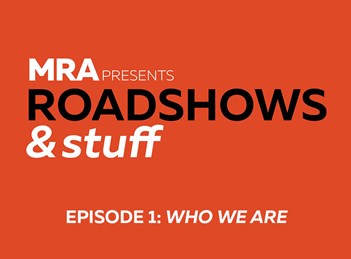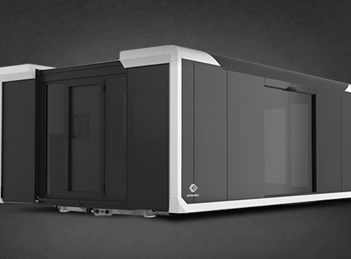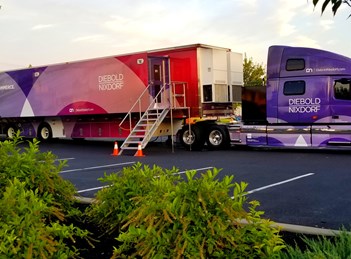
Global Consistency: How an International Truck Roadshow Collaboration is Driving Brands to Worldwide Success
Consistent roadshow experiences across more international territories. That’s the central promise of an enduring collaboration between EMS – The Roadshow Experts and American firm MRA Mobile Experiential. Chief executives Keith Austin and Tony Amato shared their thoughts on the future of this pioneering relationship.
How did the collaboration begin?
KA: “Due to its infrastructure the US is, and always will be, the home of roadshows. We wanted to work with US companies and take their customers into European locations. In return, our customers could create a consistent experience in the US.
“It began with MRA’s founder and previous CEO, Harry Kurtz. We went to meet the MRA team and the relationship has grown ever since, resulting in projects including Infinera and Ortho Clinical Diagnostics. Today, Tony and I have great synergy in our vision and we’re both are aligned on the type of projects we take on.”
TA: “It was in the makings for over a decade. Early on, we’d have calls that required a European hand with execution. When I took over the company in 2013, we solidified the relationship. I felt it needed to be an anchor of our storyline to have a strong, supportive partner that is likeminded, built the same, and that we could have confidence in recommending to our clients.”
How does the collaboration benefit clients?
KA: “It gives us detailed knowledge of very different markets. And it’s not easy for customers to find complementary roadshow agencies, where production facilities, experience, quality and service delivery are all aligned."
“Duracell is the perfect example. It was able to build the concepts and develop for the EU market after initially working with MRA in the US. We made some changes to account for cultural differences (for example, the desire for BBQ space in the US was replaced with coffee stations in Europe). But the overall experience and quality were the same, because EMS and MRA are likeminded and dominant in our markets.”
TA: “It all becomes a seamless transaction. When you go over international waters and international borders, there’s a lot to consider – including how audiences react to mobile environments. Add in the combined resources across both companies, and the number of countries we can touch, and brands can really activate seamlessly around the globe.”
What are benefits of having a global reach across the collaboration?
KA: “EMS supports global brands, so we needed a partner to help our clients with local US knowledge. Our clients want a consistent approach to deliver against their business objectives, but with a local adaptation.”
TA: “Clients don’t have to reinvent the wheel. If something works in one country, we can tweak it to work in another country and allow it to be sourced centrally. So, both companies can pass on best practices to each other – whether that’s design cues, interaction cues, presentation cues or technology cues.”
How do you see the relationship growing?
KA: “We believe the market will grow. With a potential trade deal impending, there will be more opportunities to promote European businesses in the US and vice-versa. A drive in trade and demand will increase the relationship.”
TA: “It’s constantly evolving. I see growth coming with new equipment, new software, and different types of modelling on how to increase our offerings to our clients. That will really solidify that we are the premier operators in the world.”
What’s the best thing you’ve learned from each other?
KA: “There lots of miles between us, but we face the same day-to-day business challenges. It’s great to be able to speak to someone that understands those issues.”
TA: “The business side of things, planning aspects, and how we structure our companies. We really feed off each other. It also gives us a chance to sell elsewhere in confidence. So, when EMS has an office in Dubai it gives us a stronger voice to sell in Dubai – and vice versa.”
How have you adapted through the pandemic?
KA: “The resource we provide – high quality temporary space – has been used in the fight against the pandemic. The only difference is it’s being used for testing or analysis. But the principles are the same.”
TA: “We’re adapting how we execute programs. We understand the risks out there, so we're really emphasising, to give confidence to our clients, the risks and the benefits of our programs. We’re offering different products and making sure clients realise what else is available.”
How will businesses change their marketing post-COVID?
KA: “Digital was top choice for many during the pandemic. Now, more people will consider roadshows. We’re forecasting a surge and increasing our fleet and team. Building and developing relationships is at the core of what we do.
“Businesses that are keen to change their marketing strategy, but have lost money on exhibitions, may now be more cautious. After 12 months without exhibitions, do they still need them? Then there are those that have been forced to do something different. Hybrid events have been an area we’ve worked on with our clients for several years, increasing the reach of roadshows to accommodate those who can’t make events, including time-poor senior figures. The popularity of hybrid events is growing and the flexibility they offer is clear.”
TA: “Mobile has now really jumped ahead of a lot of other types of marketing executions. The ability to go door-to-door and access communities is invaluable. We’re just in the beginning stages of seeing how it's going to constantly grow. Mobile has always been there, but now people are starting to recognise it must be a main part of their marketing budget.”
What is your view on truck roadshows of the future?
KA: “Environmental awareness and sustainability is the future. It will shape and develop our industry in the coming years. We’re often asked: ‘why a big truck?’ Quite simply, it’s better than lots of people in multiple cars.
“The gamechanger will be hybrid or electric vehicles. If you can get an electric truck with a decent range, that will transform things. Technology has made people more dispersed than ever. It’s difficult to get big groups together, so targeted groups in small spaces are the way forward.”
TA: “A lot of business plans are going to have to adapt and look at mobile as a mainstay of what they fund. Mobile gives you a tangible asset that can travel and be flexible. That's the beauty of it. It’s not set in stone. You can adapt the interiors to what you want to accomplish. It could be training one day, and product demonstration the next. It’s the prime time for this industry to grow.”





